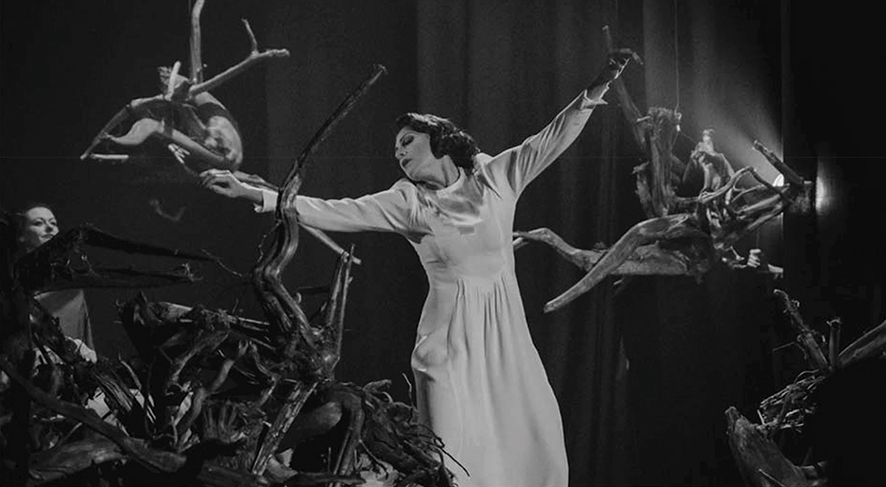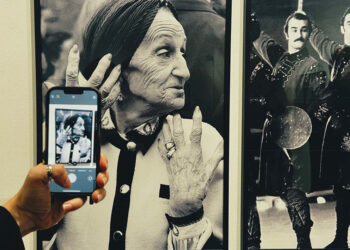Amid the tense atmosphere of street protests in Tbilisi against police violence, the stagnation of Georgia’s EU accession, and disputed election results, the 25th Tbilisi International Film Festival became an unintentional battleground for artistic expression and civic unrest. While the Georgian Panorama program was canceled in solidarity with the protests, the international section proceeded, offering audiences a striking array of films that resonate deeply with the current sociopolitical climate. These five cinematic masterpieces provided a mirror to contemporary struggles, each in their unique way illuminating the complex dynamics of power, resistance, and individual agency.
Love by Dag Johan Haugerud: Redefining Human Connections
Dag Johan Haugerud’s Love, the final installment in his trilogy, is a profound exploration of human relationships and the art of conversation. It eschews grandiose drama for subtle, authentic interactions, showing how understanding, empathy, and tactful dialogue can lead to meaningful connections. In a society often driven by polarization and confrontation, the film becomes a quiet yet powerful manifesto for creating a more mentally resilient and emotionally intelligent community.
At its core, Love underscores the importance of communication. Haugerud’s characters engage in conversations that are neither overly dramatic nor intellectualized but are rooted in honesty and openness. These dialogues illuminate the diverse ways people approach relationships, sexuality, and societal norms. For instance, the interactions between Marianne and Ole Harald, or Tor and Björn, demonstrate the transformative power of respect and vulnerability.
These moments showcase how human connection can transcend societal prejudices and expectations, offering a path to deeper understanding. This message is especially relevant today, as contemporary societies grapple with increasing divides—whether along political, cultural, or ideological lines. The film suggests that fostering respectful, nonjudgmental spaces for dialogue can help bridge these divides.

What sets Love apart is its celebration of tactful, mentally resilient individuals who prioritize care and respect in their relationships and interactions. The film doesn’t advocate for radical actions, but rather for the quiet revolution of understanding and kindness. This ethos is particularly poignant in the context of social movements, where the balance between passion and tact is critical. The conversations in Love remind us that sustainable change often starts with individual choices to listen, empathize, and connect. This approach can help mitigate the cycle of violence and alienation, fostering a culture of solidarity and mutual respect—a necessity for both personal and societal growth.
Souleymane’s Story by Boris Lojkine: Migration and the Human Condition
Boris Lojkine’s The Story of Souleymane is a gripping social drama that delves into themes of systemic injustice, personal integrity, and survival in the face of relentless institutional indifference. With an electrifying performance by Abou Sangare, the film sheds light on the plight of asylum seekers, their precarious existence, and their entanglement with exploitative intermediaries.

One of the film’s central narratives is the breakdown of trust in state institutions, represented by Souleymane’s reliance on a broker, Barry, to navigate the opaque and often hostile asylum process. Souleymane’s real story, marked by hardship and perseverance, is deemed insufficient by Barry, who fabricates a politically charged narrative to ensure success. This reliance on deception is born not out of malice, but out of a lack of faith in a system that prioritizes bureaucracy over humanity. A common thread is the erosion of public confidence in institutions meant to uphold justice, democracy, and progress.
When systems fail to deliver fairness, individuals and groups often turn to alternative—sometimes morally ambiguous—means to protect their interests. Souleymane’s Story starkly illustrates the human cost of this dynamic, showing how systemic failures force individuals to compromise their values just to survive.
The film also highlights how institutional neglect creates fertile ground for exploitation. Barry’s role as an intermediary, profiting from Souleymane’s desperation, mirrors the broader issue of predatory practices thriving in spaces where governance is weak or corrupt. The delivery app system in the film, which prioritizes consumer convenience over the well-being of its workers, offers another layer of critique. It underscores how systemic disregard for vulnerable individuals perpetuates cycles of exploitation.
At the heart of Souleymane’s Story lies a profound moral conflict: the choice between honesty and expediency. Souleymane’s hesitation to embrace Barry’s fabricated story reflects a universal struggle between maintaining personal integrity and navigating a system rigged against the vulnerable. This internal battle mirrors the broader societal challenge of pursuing truth and justice in the face of overwhelming systemic obstacles. Souleymane’s Story serves as a powerful indictment of systemic failures and a call to action for societies worldwide. It challenges audiences to confront the human cost of broken institutions and to strive for systems that uphold fairness, transparency, and dignity.
The Seed of the Sacred Fig by Mohammad Rasoulof: Philosophy as Resistance
Mohammad Rasoulof’s The Seed of the Sacred Fig offers an urgent and powerful lesson for grappling with authoritarianism, systemic injustice, and the collective struggle for freedom. By exploring themes of moral compromise, generational divides, and resistance, the film resonates deeply with the ongoing protests in Tbilisi. Iman’s journey from reluctant investigator to an enforcer of authoritarianism illustrates the devastating effects of moral surrender. His initial unease about signing death warrants is overtaken by fear and self-preservation, highlighting how authoritarian regimes sustain themselves through the quiet compliance of ordinary people. As Rasoulof suggests, “Our power is in our refusal.”

The stark generational divide in Iman’s household mirrors broader societal fractures. His daughters embody youthful defiance and hope, while his wife Najmeh represents survival through compromise. The gun in The Seed of the Sacred Fig serves as a chilling symbol of state violence, always present and ready to suppress dissent. The parallels to brutality in Tbilisi’s streets are undeniable. As demonstrators face tear gas, arrests, and physical violence, the film underscores how these tools of repression are universally employed to quash resistance and intimidate movements for change.
Rasoulof’s incorporation of real footage from Iran’s 2022 protests adds a visceral authenticity to his narrative, reminding viewers that art and reality are deeply intertwined. Ultimately, The Seed of the Sacred Fig is not just about Iran—it’s a universal critique of authoritarianism and a rallying cry for ordinary people to assert their agency. The film reinforces the message that refusal—of complicity, of silence, of fear—is the foundation of any meaningful change. By connecting personal morality to systemic resistance, Rasoulof’s work offers a cinematic blueprint for resilience and rebellion in the face of state violence.
Maria’s Silence by Davis Simanis Jr.: The Cost of Courage
Davis Simanis Jr.’s Maria’s Silence offers a reflection on the devastating impact of totalitarian regimes, personal courage in the face of authoritarian oppression, and the resilience of art as a tool for resistance. While rooted in the tragic story of Latvian actress Marija Leiko during Stalin’s Great Purge, the film’s themes resonate profoundly with contemporary struggles.
Marija Leiko’s eventual realization of the Soviet regime’s cruelty and her reluctant complicity highlight the perils of remaining silent. In Maria’s Silence, silence becomes a symbol of complicity, a weapon wielded by authoritarian systems to suppress dissent. Leiko, a celebrated actress, finds herself caught in the machinery of a totalitarian regime, her art weaponized to serve propaganda. Yet her life story, as depicted by Simanis, underscores the transformative power of art and intellectual resistance.

Simanis’s meticulous historical reconstruction of Stalinist Moscow highlights the enduring shadow of totalitarianism in modern politics. The chilling continuity between the USSR’s tactics of silencing dissent and the modern-day repression in Russia calls for vigilance. Maria’s Silence suggests that the historical atrocities of regimes like Stalin’s remain alarmingly relevant, challenging societies to confront these patterns in their own contexts. Through its black-and-white cinematography and homage to German Expressionism, Maria’s Silence also becomes a metaphor for the survival of art amid oppression. It is not just a historical tale but a cautionary narrative for societies grappling with authoritarian threats. Simanis’s work resonates as both a historical indictment and a timeless rallying cry, urging modern audiences to resist silence, remember history, and fight for justice.
Under the Volcano by Damian Kocur: Choices in Times of Crisis
Damian Kocur’s Under the Volcano masterfully avoids simplistic propaganda or overt hatred, even as it navigates the harrowing realities of war. Set against the backdrop of the Russian invasion of Ukraine, the film delves into the personal and emotional consequences of global catastrophe, asking profound questions about guilt, anger, and individual agency.
The film centers on the Ukrainian family’s abrupt transformation of a holiday into a permanent exile, illustrating how global crises force individuals into unexpected and often excruciating moral dilemmas. As the family struggles with their disconnection and the uncertainty of their future, Nastya’s determination to maintain stability serves as a metaphor for societal efforts to preserve cohesion during crises. Kocur skillfully juxtaposes the mundane—like a conga line of oblivious tourists—with the profound emotional weight of war. This contrast captures the absurdity of a world continuing as if unaffected by unfolding disasters. This cinematic irony compels viewers to confront the disparity between awareness and action.

A crucial strength of Under the Volcano lies in its refusal to reduce complex realities to a simple narrative of enmity. Instead of fostering hatred, it examines how catastrophic events force individuals to wrestle with guilt, anger, and the morality of their choices. Kocur’s film emphasizes how individuals interpret shared events differently, as highlighted in a lighthearted yet poignant debate about Brad Pitt’s presence in Titanic. This idea underscores the need for empathy and understanding in times of crisis—a lesson critical for both the family in the film and the fractured political landscapes. By focusing on individual agency, resilience, and shared humanity, Kocur’s film serves as a vital reminder of the power of personal and collective action in shaping the course of history.
The 25th Tbilisi International Film Festival will be remembered not only for its cinematic offerings but also for its profound connection to the city’s unfolding story of resistance. These five films transcended the screen, offering lessons in resilience, solidarity, and the enduring fight for justice. For audiences in Tbilisi and beyond, they served as both a reflection of current struggles and a source of inspiration for the path ahead. In a time of turmoil, art once again proved its power to unite, provoke, and transform.
By Ivan Nechaev














